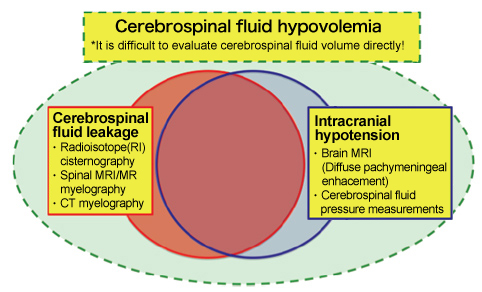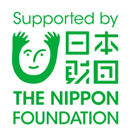
Thank you very much for visiting our website.
We assume that the visitors to our website are medical personnel or patients and families who are concerned about the various symptoms resulting from leakage or decrease in cerebrospinal fluid.
In Japan, in the past decade, many patients have been suffering from symptoms including headache, referred to as "malaise,” caused by cerebrospinal fluid leakage or decrease resulting from various traumas including traffic accidents. These patients were either cured or demonstrated significant improvement by undergoing the blood patch therapy. The number of patients undergoing the therapy per year has been thousands or more.
In particular, patients who suffer from intractable whiplash after traffic accidents have accounted for half of the total number of patients undergoing the therapy per year, and their legal actions against insurance companies refusing the payment for such damages have eventually been recognized as social problems. Many cases of improvement have been observed with the blood patch therapy in the past decade.
Japan became a car-using society at an early stage in Asia. If we drive a car, subscription to automobile liability insurance (hereafter referred to as automobile liability) is mandatory.
A major issue is that the management of automobile liability has been entrusted to the private sector. In addition, for the compensation amount and accountability of the party at fault, the judge has the full authority on the court decision because a jury system for a civil trial as established in the Western countries has not been introduced in Japan. A judge in Japan tends to be strongly bureaucratic, and has to base the decision of a trial related to spontaneous cerebrospinal fluid leakage on medical expertise, where the controversy has always been "whether cerebrospinal fluid leaks by trauma," regardless of the extent of the patient's symptoms (severe or mild).
This has led to heated discussion between doctors affirming the leakage by trauma and doctors supporting the insurance companies who deny the leakage by trauma.
Although they have not treated any patients with cerebrospinal fluid leakage by trauma, the doctors denying the leakage have been holding positions in universities at the highest level in Japan, and are therefore, significantly influential in the academic community and society.
On the other hand, doctors affirming the leakage by trauma are members of the Japan Cerebrospinal Fluid (CSF) Hypovolemia Society, including Dr. Masamichi Shinonaga, who is participating in this website.
Many victims of traffic accidents visit hospitals while suffering from intractable whiplash.
On the other hand, life insurance companies deny the disease and reject payments including medical expenses. Hence, a court trial is inevitable. The plaintiffs would appeal that they have really been bedridden after the traffic accident, and their condition only improved after the blood patch therapy. However, the judge would decide that there is insufficient medical evidence. The medical evidence in Japan is usually determined based on whether there is sufficient statistical data gathered outside Japan as well, whether such evidence has obtained approval of the relevant society, and whether sufficient literature is available. Hence, new theories and new ideas are generally unacceptable in Japanese courts.
However, mass media and political parties commenced their actions towards the resolution of this social issue upon desperate appeal from patients and our Society. Finally, in 2007, the "Study Group for the Establishment of Diagnosis and Treatment of the Cerebrospinal Fluid Hypovolemia" which appointed Takamasa Kayama, Professor at Yamagata University (currently the president of Japan Neurosurgical Society), as a representative researcher, was established in Japan. The study group conducted a 9-year study trial on whether the cerebrospinal fluid would leak after a traffic accident or by minimal trauma. The study results reported that the cerebrospinal fluid leakage due to trauma occurs commonly, overturning conventional concepts.

Thus, from April 2016, cerebrospinal fluid hypovolemia is covered by Japan’s world-class distinguished system of national medical insurance.
However, this only applies to "a group of patients meeting the diagnostic criteria of cerebrospinal fluid leakage symptoms defined based on the 9-year trial," and 30–40% of total patients are assumed to be eligible for insurance application at this time.
Please refer to "What is cerebrospinal fluid hypovolemia?" page for the details.
I am a patient of spontaneous cerebrospinal fluid leakage myself, who has shown significant improvement after the blood patch therapy, and I have connected with many patients.
I founded the NPO (non-profitable organization) Corporation for patient support, and was engaged in the activities for disseminating understanding and awareness of the disease in cooperation with supporting doctors. The results of this study in Japan (the trial) could definitely be the foundation to continue to help many such patients around the world in the future.
I hope that this site would serve as a useful reference.
It should be noted that the Japanese government has decided to implement a 3-year study for 60–70% of patients who did not satisfy the diagnostic criteria (i.e., site of spinal fluid leakage not clear, but demonstrating apparently rapid absorption of contrast agents for RI examination or CT myeloperoxidase inspection; and patients whose leakage site is unclear but demonstrate improvement after the blood patch therapy due to unknown reason), as well as for children and young people.
In Japan, there are a large number of patients with this disease among truant students.
The fact that many of these students have been able to attend school after treatment has also achieved social recognition. We will also provide regular updates on this information.
Finally, it is known that many unexplored fields of study remain for cerebrospinal fluid.
In addition, in the United States and Europe, mainly in the United States, many reports assume that the discomfort similar to whiplash occurring after trauma may be a symptom of "mild traumatic brain injury" (MTBI). However, in Japan, few physicians focus their research on MTBI. We sincerely hope that the study of MTBI would advance in the near future and its treatment would be identified as soon as possible. Although some may refute, I assume from my experience that some patients with MTBI may be suffering from symptoms related to cerebrospinal fluid leakage.
Therefore, I sincerely hope that this website would serve as a reference for doctors worldwide, and that many patients would be benefitted by further research in the future.
Moreover, in the past decade, I have seen many cases of improvement with the blood patch therapy.
I would like to conclude with my favorite maxim: "Wait and hope.” the last words of the novel The Count of Monte Cristo (by Alexandre Dumas)
2021.1 CSF-JAPAN Secretariat



